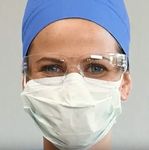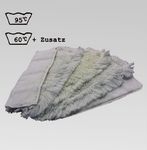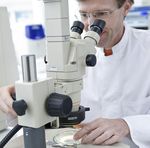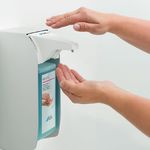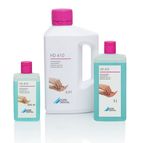HYGIENE MEASURES FOR INFECTIONS WITH THE NEW CORONA VIRUS (2019-NCOV) FROM WUHAN, CHINA
←
→
Page content transcription
If your browser does not render page correctly, please read the page content below
Hygiene measures for infections with
the new corona virus (2019-nCoV)
from Wuhan, China
Special features of the novel corona virus
What is the novel corona virus?
The new pathogen belongs to the corona virus strain. It is known
that the new pathogen is a beta coronavirus that is over 80 per-
cent genetically identical to the SARS coronavirus.
Where does the new corona virus come from?
The virus probably comes from wild animals. Accordingly, there
were first transmissions from animals to humans, then transmissions
from human to human. However, no direct transition from animals
to humans is assumed, but an for now unidentified intermediate
host.
2019-nCoV ‒ corona virus Incubation period
2019-nCoV (provisional name) is a corona virus newly The incubation period from the infection to the onset of the first
discovered in 2019, which belongs to line B of the beta symptoms averages around 5 to 6 days. However, the incubation
corona viruses. It is an enveloped virus. The virus appeared period is subject to large inter-individual fluctuations, so that a
in the city of Wuhan (China) in late 2019. The 2019 nCoV period of 2 to 14 days is possible. It is very similar to SARS. The
virus genome was fully sequenced in January 2020. viruses can be passed on already during the incubation period, i.e.
before the onset of symptoms.
Duration of contagiousness
It is believed that the time from infection to onset can be up
to 14 days.
Transmission
The pathogens are caused by
▪ droplet infection and
▪ transmitted contact infection
Because other corona viruses are also spread by smear infection,
this transmission path cannot be excluded.
stand: 02/2020Current information Coronavirus (2019-nCoV) Symptoms A 2019 nCoV infection is initially noticeable due to unspecific general symptoms. The following symptoms can occur, among others: ▪ Severe difficulty breathing ▪ Lung infection ▪ Dry cough ▪ Fever Diagnostics and therapy Diagnostics Specific diagnostics must be carried out for: ▪ People with suspected pneumonia and stay in the risk area 14 days before the onset of the disease ▪ Symptomatic people who have had contact with a confirmed case Laboratory: The virus can be detected directly using a diagnostic test. The sample material should be taken from both the upper and lower airways. A single negative virus detection does not rule out the infection. If the progession is severe, multiple tests are recommended. Therapy No specific therapy is currently available (January 2020). Therapy is therefore purely symptomatic. However, existing antiviral drugs are being examined. Measures For healthcare facilities in Germany following recommendations from the Robert Koch Institute (RKI) are given: 1. In the event of suspected cases, a procedure to prevent transmission by droplets is recommended. These include: ▪ Consistent compliance with basic hygiene measures by the staff, which includes hygienic hand disinfection ▪ Accommodation in an isolation room with an anteroom/ lock if possible, if this is not possible in a single room with its own wet room ▪ Wearing a multi-layer mouth and nose protector with a correct fit by the patient (if tolerated) ▪ In addition, the staff should use protective clothing, safety glasses, at least FFP2 masks as respiratory protection and disposable gloves
Current information Coronavirus (2019-nCoV) 2. If it is a case of an infection with the novel corona virus confirmed by laboratory diagnostics, i.a. the following measures are recommended: a) Spatial accommodation: ▪ Insulation in a single room with wet room; Single rooms with lock function / anteroom are generally preferred ▪ If a ventilation and air-conditioning system is operated in the patient rooms that allows air to spread to other rooms, this must be switched off ▪ Visitors are to be kept to a minimum and instructed about personal protective measures. b) Personal protective measures: ▪ The trained staff who are used to care for these patients should be released from the care of other patients as far as possible ▪ Protective gowns, disposable gloves, hood, close-fitting breathing mask (protection level FFP2 or FFP3) as well as suitable protective glasses and waterproof disposable apron for appropriate nursing, diagnostic or therapeutic activities on the patient Further hygiene measures ▪ Daily wiping disinfection of the areas close to the patient ▪ Daily wiping disinfection of areas close to the patient If necessary, the disinfection measures should be extended to other areas at risk of contamination or contaminated areas ▪ All medical devices in direct contact with the patient are to be used patient-related and must be disinfected after use. A central preparation is possible for transport in a closed, externally disinfected container. A thermal disinfection process should, if possible, be preferred ▪ Transport dishes in a closed container to the dishwasher and wash at > 60 ° C ▪ Laundry / textiles can be subjected to a disinfecting laundry disinfection process according to the RKI list ▪ Use wipe-disinfectable covers for beds and mattresses. ▪ Disposal of waste contaminated with secretions or excretions in accordance with waste code 18 01 03 in accordance with LAGA guidelines ▪ Final disinfection is carried out with at least limited virucidal agents. Dispose of material that cannot be reprocessed ▪ When transporting patients, inform the target area / facility and the transport service ▪ After the ambulance: – Disinfect all contact surfaces – Carry out hand disinfection and washing This catalog of measures does not claim to be complete!
Current information
Coronavirus (2019-nCoV)
Disinfectants
▪ Use disinfectants with at least the spectrum of activity “limited virucidal”
▪ Follow the dosage and exposure times according to the manufacturer‘s instructions
for the disinfectants used
▪ Reuse of disinfected areas:
Reuse of disinfected areas: According to the RKI recommendation, the area can be used again
after all routine surface disinfection measures have been carried out as soon as it is visibly dry.
In certain cases, the specified exposure time must be waited for before the area is used again.
The following Dürr System Hygiene products work against the new type of corona virus:
Surfaces
▪ FD 300/ FD 300 top wipes Surface disinfection
▪ FD 312/ FD 312 wet wipes Surface disinfection*
▪ FD 322/ FD 322 premium wipes/ FD 322 top wipes Quick-acting disinfection
▪ FD 333/ FD 333 wipes Quick-acting disinfection
▪ FD 333 forte/ FD 333 forte premium wipes/FD 333 forte wipes Quick-acting disinfection
▪ FD 350 Disinfection wipes
▪ FD 366 sensitive/ FD 366 sensitive wipes/ FD 366 sensitive top wipes
for disinfection of sensitive surfaces
Skin and hands
▪ HD 410 Hand disinfection
Legal basis
Notification according to the Infection Protection Act (IfSG):
In Germany, according to the Infection Protection Act (Section 6), the occurrence of a threate-
ning communicable disease must be reported to the responsible health authority. With effect
from February 1, 2020, an ordinance was passed by the Federal Ministry of Health (authoriza-
tion pursuant to Section 15 IfSG) to extend the reporting obligation. Accordingly, suspicion of
illness, illness and death as well as laboratory chemical evidence of an acute infection with the
novel corona virus must be reported. The suspicion must only be reported if the suspicion is
based on both the clinical picture and a probable epidemiological connection.
*Use biocides with caution. Always read the label and product information before use.
Dürr Dental SE
Höpfigheimer Str. 17
Stand: 02/2020
74321 Bietigheim-Bissingen
Germany
www.duerrdental.com
info@duerrdental.comYou can also read





